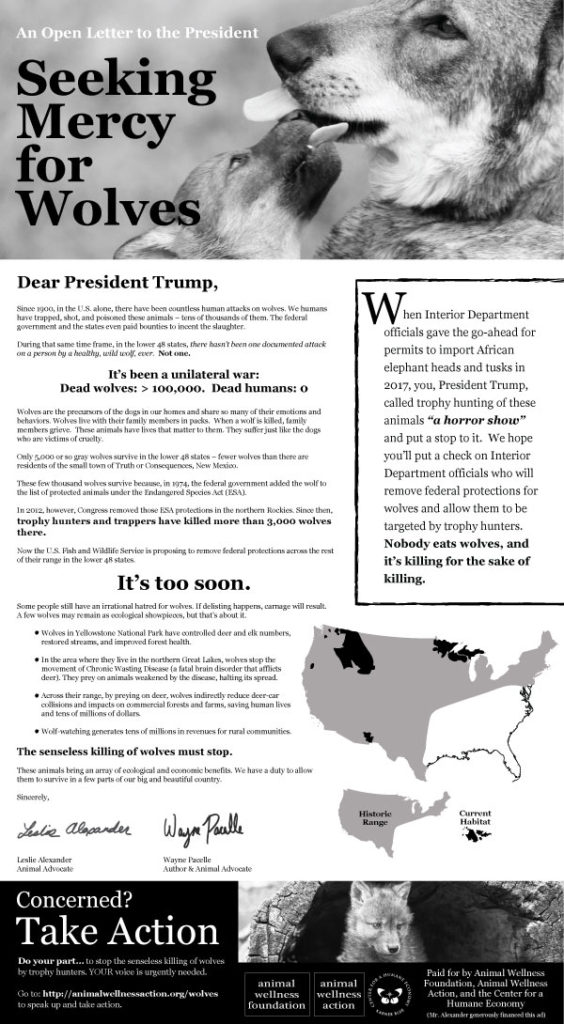Animal Wellness Launches Ad Campaign Urging President Trump to Direct the Interior Dept. Not to Strip Federal Protections for Wolves
WASHINGTON, D.C. — Today, Animal Wellness Action, the Animal Wellness Foundation, and the Center for a Humane Economy released a full-page ad in today’s print edition of The New York Times, calling on President Trump to show “mercy for wolves” and prevent a half dozen states from opening trophy hunting and trapping seasons by maintaining their status as “threatened” or “endangered” across much of their range in the contiguous states.
“Since 1900, it’s been a one-sided war between humans and wolves,” said Leslie Alexander, co-author of the published letter to President Trump and the financial supporter of today’s advertisement. “Humans have killed more than 100,000 wolves, and healthy wolves have not killed a single person. “
“We’ve got to stop the hysteria and hating and begin to understand that wolves bring a range of benefits to the regions they inhabit,” added Wayne Pacelle, co-author of the letter and founder of Animal Wellness Action. “It’s too soon and too risky to unleash trophy hunters and trappers to kill them, and it’s self-defeating because wolves, through their natural behavior, improve the health of ecosystems, reduce crop and timber losses by controlling prey populations, reduce the frequency of deer-auto collisions, and act as a bulwark against the spread of wildlife diseases.”
Gray wolves, virtually eradicated from the lower 48 states in the latter part of the 19th century and early part of 20th, have had a slow walk back from near extirpation. For decades, federal, state, and local governments offered bounties on wolves and also executed their own government-sponsored predator-killing operations — a slaughter that stands alongside the massacre of bison as among the most wanton chapters in the history of American wildlife management.
With wolves holding on only in the northern tier Minnesota by the early 1970s, the federal government established protections for gray wolves under the Endangered Species Act, and in the decades since, they have only slowly increased in number and reclaimed a fraction of their original range. Just more than 5,000 wolves survive in the contiguous states, and they face a range of threats, including poaching, mistaken identify killing, habitat loss and fragmentation, disease, intra-specific aggression, and other threats.
“Wolves feel pain just like dogs do,” noted Mr. Alexander. “Killing these family-oriented animals just for trophies or snaring them or catching them in a steel-jawed leghold trap is deeply disturbing to me and so many other animal lovers.”
The ad campaign will continue at least until the public comment period on the wolf de-listing proposal ends on July 15th.’

A copy of the advertisement in the New York Times is attached, and those who want to support this effort can donate here.

